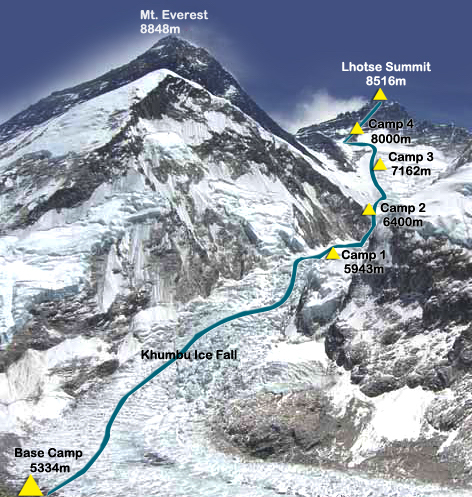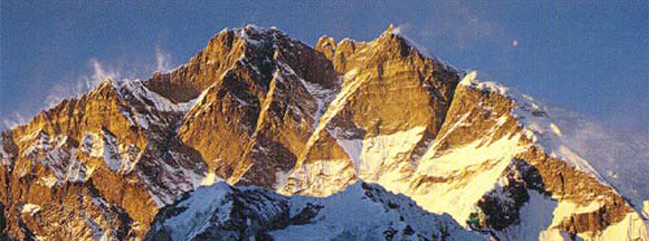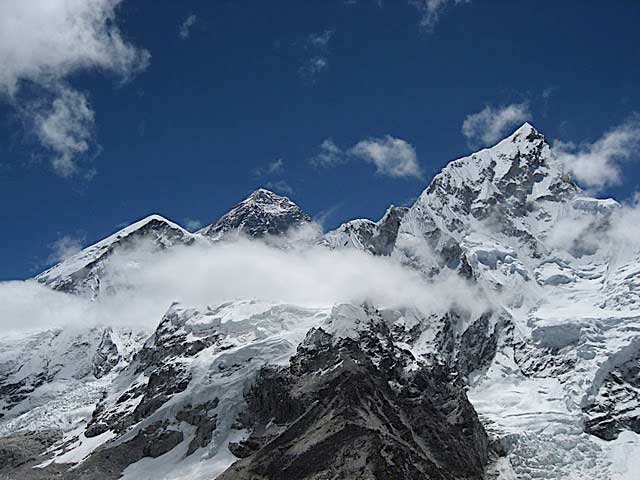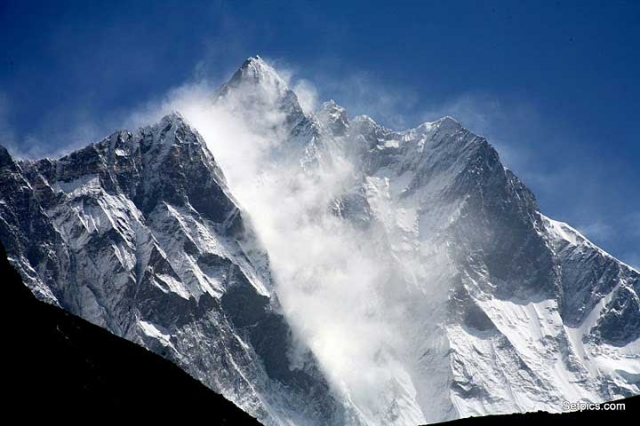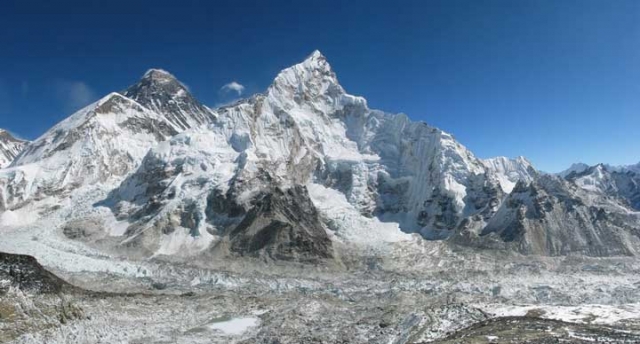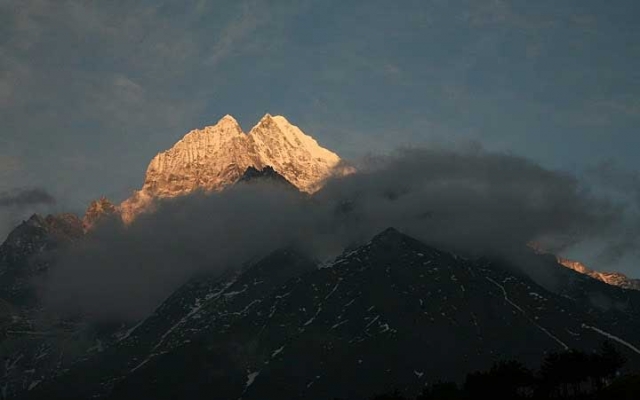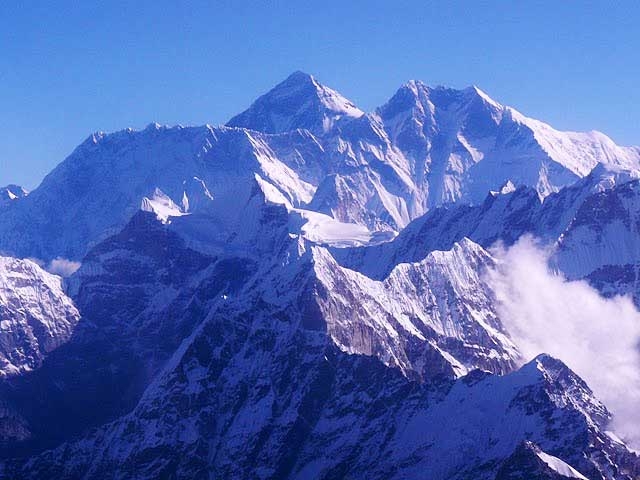Mount Lhotse (8516) was climbed by a Swiss expedition in 1956. Its lower peak, mount Lhotse Shar 8383m, sometimes considered a separate 8000m peak, Mount Lhotse , which means “South peak” is a part of the Everest massif, just to the south of Everest. The primary route on mount Lhotse is via Everest’s South Col. But by 1955, despite the activity on Mount Everest, Lhotse was the highest unclimbed peak in the world.
The first attempt on Mount Lhotse was by an international team in 1955. One member of the party was Erwin Schneider; during this expedition, he began work on the first of the series of high-quality “Schneider maps of the Everest region”. The same Swiss party that made the second ascent of Everest in 1956 made the first ascent of Mount Lhotse from a camp just below the South Col.
Mount Lhotse Shar was first climbed by an Austrian expedition in 1970. Japanese, South Koreans, and Germans attempted from various routes on its main peak. Poles and Italians also climbed the summit before the summit was reached again by German expeditions in 1977.
The Lhotse Face/Route
The western flank of Lhotse is known as the Lhotse Face. Any climber bound for the South Col on Everest must climb this 1,125m (3,700ft) wall of glacial blue ice. This face rises at 40 and 50 degree pitches with the occasional 80 degree bulges. Two rocky sections called the Yellow Band and the Geneva Spur interrupt the icy ascent on the upper part of the face.
The south face is one of the most impressive walls in Himalayas. The first expedition from the south side was Yuogoslavian leading by A.Kunaver. They selected the left side of the wall but they manage to only get to 8100 meters. In 1985,1987 and 1989 three Polish expedition tried to climb the wall. The highest point they reach was 8300 meters. During the last expedition, Jerzy Kukuczka-the second person who climbed all 8000 meter peaks died during the attempt. Another expedition in 1989 lead by Reinhold Messner failed due to problems between members.
In 1990 Tomo Cesen said that he climbed the wall via Yugoslavian route. The climb caused much controversy because many climbers didn’t believe that the wall, which was unclimbed by so many good climbers, was by climbed by single person. He later changed his mind claiming that he didn’t reach the top but the summit ridge. However, public opinion is that he reached only about 7000 meters.
The south face was finally climbed in 1990 by Russian expedition few months after Cesen’s climb. They describe the wall as impossible to be climbed by a single person.
Day:01 Arrival KTM & transfer to hotel -1300m/4264ft
Upon your arrival in the Tribhuvan international airport, our representative will welcome you and will assist to transfer you in your hotel in Kathmandu. You may relax at your hotel or go around for shopping. In the evening Himalayan Glacier Trekking will organize welcome dinner for you in one of the typical Nepalese restaurant in the heart of Kathmandu meanwhile briefing about your adventurous trip will take place. Overnight at hotel.
Day:02-03 At leisure in Kathmandu
Sightseeing and Preparation for Everest Expedition. While the leader attends a formal briefing in the Ministry of Tourism, you will explore the fascinating city of Kathmandu. You will visit famous Stupa, Boudhnath and the popular Hindu pilgrimage site, Pashupatinath Temple. In the late afternoon, the leader will check everyone’s equipment, as Kathmandu is the last opportunity to buy anything missing. You will also get introduced with fellow expedition members and guides. Overnight at hotel.
Day:04 Fly Kathmandu to Lukla – 2,840m/9,315ft
An early morning scenic flight to Lukla. In Lukla, we will meet our camp staff and porters and set off straightaway for our first night’s stop at Phakding. Situated on the banks of the Dudh Kosi which drains the whole of the Khumbu region, Phakding on the main trade route through the area and there are a number of clean well-built lodges where we can spend the night.
Day:05 Trek to Namche Bazar
Continue up the banks of the Dudh Kosi, crossing it twice by small suspension bridges before reaching the village of Monjo where we will enter the Khumbu National Park. Cross the confluence of the Dudh Kosi and the Bhote Kosi on a high suspension bridge and climb steeply for about two hours to reach Namche Bazaar. This is a prosperous trading town and the capital of the Khumbu region with genuine Tibetan artifacts.
Day:06 At leisure in Namche Bazar
We spend a day in Namche Bazar resting and allowing our bodies to become acclimatized to the altitude of 3,450m (11,300ft).
Day:07 Trek to Thyangboche
The well worn Everest trail contours around the side of the valley high above the Dudh Kosi. Follow the path, savoring the first really good views of the great peaks of the Khumbu: Everest, Lhotse, Nuptse and Ama Dablam. Passing by several villages and numerous tea shops, cross the Dudh Kosi River and make a steep climb to Thyangboche, home of an impressive and newly rebuilt monastery.
Day:08 Trek to Dingboche
Shaded by rhododendron trees, the path leads gradually down to the river once again to another airy suspension bridge. An hour’s walking from here brings us to Pangboche, an excellent viewpoint for Ama Dablam. Contouring up the valley side, re-cross the river and turn up the Imja valley to reach the picturesque farming village of Dingboche.
Day:09-14 Acclimatization
This is an important phase of the expedition. Dingboche is a good location for acclimatization. The team leader will organize daily outings to the adjacent hills with the aim of providing gradual acclimatization. Walk some of the nearby hills in order to slowly increase exposure to altitude. Follow the regime that you have previously found most suitable, in order to give you maximum acclimatization before arrive in base camp.
While in Dingboche, we can attend a seminar on high altitude acclimatization at a hospital run by the Himalayan Rescue Association nearby Pheriche. The walk over to Pheriche and back will also serve as good acclimatization training.
Day:14-40 Climbing period of Lhotse and Back to Base Camp
Day:41:43 Trek to Namche Bazaar via Dingboche and Thyangboche
Day:44-45 Trek to Phakding and Lukla
Day:46 Fly Lukla to Kathmandu
We will return to the welcome haven of the Hotel. Once back in Kathmandu, Himalayan Glacier will host an evening barbecue to celebrate the expedition and as a farewell party to thank the Sherpas for their support and friendship.
Day:47 Rest day in Kathmandu
Today the journey comes to an end. There’s nothing to do but trade emails with your new friends, organize all your photos and final preparation for departure from Nepal.
Day:48 Departure to your next destination
The Climb:
Trek to Base camp:
The initial days of trekking takes us deep into the Khumbu Valley. The moderately paced trek also helps in enough time for acclimatization. Walking past several Sherpa villages also provides an opportunity to acquaint with the Himalayan culture. The trek winds through some of the most spectacular mountain scenery on earth, where you can relax in exotic, friendly Sherpa villages. Our trusty yaks and porters carry all of your baggage, so you don’t have to carry a heavy rucksack.
Base camp to Camp 1:
The Base Camp for Lhotse is the same as for the Everest Expedition. Other camps are Camp 1, Camp 2, and Camp 3 and then you split off from there to a Lhotse Camp 4. Clip in to the fixed lines to head through the Khumbu Icefall up to the plateau of the Western Cwm and camp 1, at 5,800 metres/19,000 feet.
From Camp 1 to Camp 2:
The route traverses the flattish bottom of the Western Cwm, to 6,200 metres/20,300 feet to camp 2. Camp 2 is located on a rocky moraine below the west-face of Everest. In camp 2 our sherpa cook will prepare hot meals and drinks.
Camp 2 to Camp 3:
Located on a flat section protected by solid ice walls at about 7,200 metres/23,600 feet on the Lhotse face. To reach camp 3, we must negotiate the Lhotse Face. The Lhotse face is not very technical, in fact, after climbing the initial 38-65 degree 100 metre/300 foot high ramp, the average slope angle of the entire ‘face’ is around 30 degrees.
Camp 3 to Camp 4:
Located upon rock shelves on the upper Lhotse face. It is the highest camp at 7850 metres/25,700 feet, and can be an airy perch for the few days we reside there. Camp 4 at 7850 metres/25,700 feet on the upper Lhotse face.
Q. I want to climb for Expedition, but there are so many options and the cost is high! Why should I choose Kiwi Sherpa ? What makes you different to other companies out there?
A. As we all know that when you make a decision to climb for expedition, it is one of the most financially challenging trips to come on. Our prices compared to other outfitters that provide the same product, services, if not a lesser product are actually less! We invite you to shop around and compare, both in price and quality. We feel strongly that you will find us to be the best in the business.
One of the main things that set us apart is our attention to detail. Nowhere else you will find a team of people more dedicated to your success! From the time you contact the office to the time you step on the mountain, our customer service is the best.
Our trip prices are much more reasonable compare to many global based companies; it is not because we are economical in service in which we operate. We are local operator therefore we DO NOT re-sell or use second party or agency. Many international companies will take anything from one third to three quarters of the profits this is how your trip price makes huge unusual.
Q. How the Expedition will operate?
A. After meeting all your team and crew in Kathmandu we fly by helicopter, drive by vehicle or fixed wing plane directly to the destination and then we start for trekking. Acclimatizing along the way and relishing in the hospitality provided by our Sherpa friends we reach base camp and after some rest and preparation we begin the ascent. Base camp will be a collection of sleeping tents, as well as a large kitchen and dining tent. We utilize the services of specially trained Sherpa cooks and we import a lot of high quality food to supplement the local produce available. The guides and Sherpas will fix rope on the route and stock the camps with provisions and equipment. By utilizing fixed rope we can climb in average weather, and, if necessary descend to base camp with little problem in case of a major storm. Two or three climbing Sherpas will assist with the load carrying but no more will be engaged in order to avoid clogging the route and spoiling the nature of the climb. When the fixed line is in place, and the two camps are established and stocked, we will climb back up the ropes and make a bid for the summit. Sufficient supplies will be available to support all members. Guides and Sherpas will carry all group gear but members are expected to carry their own personal gear. Radios will be used to co-ordinate the movements on the mountain and provide a safety back-up for the lead team.
Q. Can my friends and family come along to base camp for the expedition?
A. Sure! This is one of the best points to start the expedition, having family and friends trek to base camp to see you off on your journey. Base camp for non-climbers is not a very hospitable place, but we strive to make your guests comfortable and welcome. Guests for the duration of the expedition are allowed on a case by case basis. The reason for this is simple. On the trip, our job is to be climbing, spending time just at base camp can be quite boring sometimes, so we usually encourage guests to trek in at the beginning or end of the expedition, to join you during the most exciting parts of the trip! Contact us for cost and details.
Q. As the trip is so long, can I bring food and other gear not on the list?
A. Of course! Most people on the Expedition, members end up bringing “the kitchen sink”! We encourage you to bring some of your favorite goodies and tech toys, as base camp will become our home for 2 months or so. The more comfortable you are, the more energy you have for the climb, so every little thing helps!
Q. Is there a private trip option too? If yes, how does that work and what are the costs?
A. Doing Expedition is a once in a lifetime experience, we wanted to make sure you have every possible advantage. Some clients enjoy the added privacy and schedule flexibility that a private expedition allows. A private means you will have your own guides, your share of the Sherpa carry staff, a private dining tent, and optional private communication facilities. This allows you to climb at your own pace, and enjoy the mountain on your own terms. The costs vary depending on how many clients there are in your private group. Please contact the office for details.
Q. Are the skills/prior experiences required for this climb?
A. Simply, You cannot just decide to write a cheque and go and climb for Expedition ! A comprehensive climbing resume is required to join our team. The most required factor on our ‘Kiwi Sherpa’ is that the participants must have a solid understanding of mountaineering skills. This should include previous high altitude experience of at least 6,000 meters, mixed with a multitude of Alpine mountaineering and, preferably, you will have taken part in a previous 8,000-metre expedition. Please let us know if you want us to arrange training program in some of the 6000 and 7000 meters peaks in Himalaya before your expedition begin.
Q. What is the conditioning level needed for this climb?
A. You should be in the best shape of your life! This is our longest expedition of the year. It requires patience, stamina, mental fortitude, and a strong will. Summit day can sometimes be over 20 hours long! Day by day the challenges are different, but the more prepared you are, both mentally and physically, the smoother your trip will go.
Q. In a team, how many climbers will be on this expedition?
A. Maximum 10 members can be included on our Kiwi Sherpa. This is to ensure that we can maintain safety and our attention on detail. There may be more in base camp and in the camps on the mountain if there are private expeditions, but they will generally travel separately from the main team.
Q. Will I be sharing a tent or room with other climbers? Is there a single room option on this trip?
A. You will have your own tent in base camp, but on the mountain, you will be sharing a tent with others. We generally book you in to a single room in the hotel in Kathmandu whilst it is twin share in the lodges on the trek into base camp. A single supplement is available. Please contact us for further details.
Q. How heavy will my pack be?
A. It will depend on the day. On a “carry” day, where you are moving your personal gear between camps, your pack can be 20-40lbs, equal to 9-18kg , sometimes higher if you choose to carry more of your equipment. On “move” days, the weight goes down significantly, to 10-15lbs., 5-7kg.
Q. What kind of food do you have on the mountain? Or at the base camp?
A. All these will depend on what camp we are in. In the base camp, we import tons of food from Kathmandu. So don’t be surprised by our sushi nights, fresh muffins, yoghurt for breakfast, and pizza! On the mountain, we usually have a wide variety of meals; these are significantly tastier than freeze dried, as they are real food and ready to heat and eat! At Camp 2, our advanced base camp, we have Sherpa cook staff, who prepare more ‘base camp like’ food. Pizza, pasta, eggs and bacon! We work hard to make sure our food is second to none.
Q. How long will be a typical day on the mountain?
A. It depends on the day and your level of acclimatization. At the beginning of the trip, everything seems slower and longer, but as you get more adjusted to the mountain, the days go quicker. Average days can be 5-10 hours long. Summit day can be up to 20 hours long.
Q. Is communication possible on the expedition? If yes, what its type?
A. Experience has shown how important it is on expedition to be able to talk to every team member, at all times. If you join Kiwi Sherpa on expedition, you will have a dedicated radio. Each Sherpa will also have his own radio, so that at all times we can keep in touch with everyone, and everyone can keep in touch with each other.
Base Camp is equipped with a lap top and high speed satellite connection. The satellite communications are also used to send back regular reports, every couple of days, to Kiwi Sherpa office.
Q. What sort of hotels do we stay at in the city?
A. We use standard rooms from three/four star hotels in Kathmandu with breakfast included.
Q. What time should I arrive and where do I meet my guides?
A. There will be an Kiwi Sherpa representative at the airport to meet you, and the first of many team briefing occurs in the evening of day 1 and 2 in Kathmandu with our local Sherpa guides.
Q. How much should I budget for this expedition? How much cash should I plan to bring?
A. Since this is our biggest and longest trip, we usually suggest our expedition members to bring USD$2000 -$3000. This will cover everything from gifts, to bottled drinks, tips, and anything else that catches your eye on the trail. ATM cash machines work in Kathmandu, but only pays the local currency, Rupees.
Q. How much should I tip my guide staff?
A. This is a difficult thing to gauge. We have seen everything from 100USD to 15,000USD for an Expedition tip. Tipping is not required, but a small way to show your guides thanks for their help. The level of the tip should reflect the level of personal involvement with your guide.
The suggested tipping are as follow:
– Allow $150-250 for general non-sherpa crew who stay at base camp.
– Allow $200-350 for sherpas who go up to the base camp.
– Summit climbing Sherpa US$ 1000 – 1500 per Sherpa.
Q. What if I arrive early or depart late?
A. As long as possible, we request you to arrive in Kathmandu on the assigned date, to assure your baggage makes it on time, and you have time to recover from jet lag before trekking. It is hard to catch the group if you are arriving late and still waiting for lost baggage! We can arrange extra nights in the hotel. Many people depart from our Nepal expeditions later, to enjoy the sights and sounds of Kathmandu, but do keep in mind that this is long expedition and we find that people want to head home as quickly as possible after the climb finishes.
Q. Are there any entry or visa requirements?
A. Yes there are. Be sure to have the suggested USD amount in cash for your visa application and have a passport, photos for your arrival in Kathmandu. You will receive your visa at the airport, and we will add extra days later, as you are only ever issued a 90 days visa when you first arrive.
Q. Could I have my own personal Sherpa?
A. In our normal expedition you carry your personal equipment; sleeping bag, mattress/s, down suit, snacks, clothing while the sherpas carry the meals, gas, stoves, tents and oxygen. The team climbs together between camps and a climbing sherpa will also accompany you to the summit. This is a good level of service, and suits most people, however if you want an additional climbing sherpa to assist with your personal equipment and to climb with you all the time, we can provide. Please contact us.
Q. What kind of insurance do I need?
A. We invest in insurance coverage for commercial liability and medical and disability insurance for our employees and Sherpas while participating on our programs. We cannot insure you for your personal needs, but we do expect you to be as fiscally responsible as we are. We strongly recommend that you insure yourself against potentially expensive difficulties that may arise. First, trip cancellation insurance may provide financial relief should you be forced to withdraw from the climb before it even happens. Next, make sure you have adequate traveler’s medical and evacuation insurance for coverage should you have a problem during the trip. Medical care and evacuation from mountain can be expensive.
For the Rescue and Evacuation, Kiwi Sherpa strongly recommends that you purchase a Global Rescue membership to protect yourself and your family. We give you our word that you will be safer as a result. We are an authorized agent of Global Rescue, click here to sign up the membership plan today.
Q. Are the Kiwi Sherpa staff insured?
A. Our company insures all our trekking staff, including guide, cook, sherpa and porters.
Q. Can’t find your question here?
A. Contact us for further information!
Cost Includes
• Expedition Expedition permit fees
• Accommodations in Kathmandu
• Flights from Kathmandu to Lukla and back including airport transfers
• All overnight accommodations while on the trek and climb
• Meals in Kathmandu and while trekking and climbing
• Group equipment for the climb
• Qualified and Experienced guides
• Experienced Climbing Sherpas
Cost Excludes
• International airfare and Nepal Visa
• Personal equipments and extra services
• Tips and Bonus for Staff and guide
• Insurance and Trip cancellation
• Beverages
• Airport departure tax
• Helicopter Rescue
